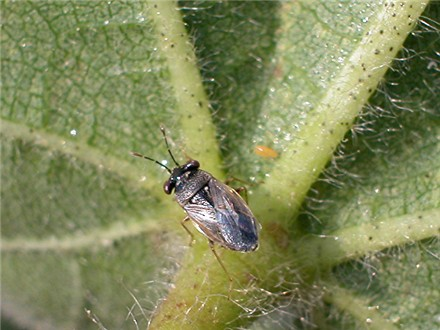LINKS
Big-eyed Bugs
Blake Layton (Mississippi State University) and Scott Stewart (University of Tennessee), Department of Entomology and Plant Pathology
General Comments:
This is one of the more abundant and easily detected predators. It is an important predator in cotton, corn, and soybeans.

These insects are commonly found in pre-blooming cotton, or in young corn or soybean fields, after flying in as adults from surrounding vegetation. In the absence of insecticide sprays, they will remain in the field for the remainder of the season. In cotton, populations of 20-40 per 100 sweeps can sometimes be found, especially in fields with a minimum of early insecticide treatments. Higher populations of tobacco budworm and bollworm can be tolerated when many big-eyed bugs are present. Despite their distinctive appearance, they are sometimes mistaken for plant bugs. There are several species of big-eyed bugs, so they are sometimes referred to by their genus name, Geocoris. Geocoris punctipes is the most common species encountered and is the one described below.
Description:
Both the nymphs and adults are well described by their common name. The head is as wide as the body and the eyes are notably large. Adults are about 3/16th of an inch long and are dull grey in color with transparent, shiny wings. The nymphs resemble the adults in general body shape, but they are a distinctive metallic silver-grey in color. The eggs are white to pink in color and are shaped like a hotdog but only 1 mm long. These eggs are often found in cotton terminals and are often mistaken for plant bug eggs. However, plant bug eggs are almost always inserted into plant tissue and are rarely seen when scouting.
Prey:
Both the nymphs and adults feed on aphids, whiteflies, mites, and the eggs and larvae of caterpillars such as tobacco budworm, bollworm and soybean loopers. In addition, they are also predators of plant bugs, especially the younger nymphs. In one laboratory study, big-eyed bug nymphs consumed an average of 151 tobacco budworm eggs or 76 first instar larvae during the 21-31 days required to complete all five nymphal instars. Late instar nymphs consumed approximately 10 eggs per day. Like many predatory insects in this order, big-eyed bugs also feed on nectar and directly on plants, causing little or no damage, but their populations may be affected by in-furrow systemic insecticides.







